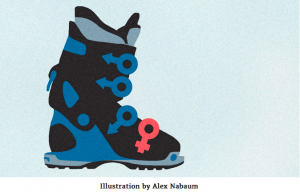LEADING THE CHARGE: IN THE AMGA, WHERE ARE ALL THE WOMEN?
LINK to article: According to the U.S. Bureau of Labor Statistics, construction work holds the lowest percentage of female representation among surveyed occupations, comprising roughly nine percent. The second lowest? Ski guiding.

That’s according to Jane Anderson, Logistics Coordinator with the American Mountain Guides Association, who notes that women comprise just 11 percent of ski-guiding personnel within the AMGA. Factor in rock and alpine guides, and female employment drops to eight percent of AMGA staffing.
Those numbers alone are striking, but the gender disparity becomes more concerning when coupled with a 2014 Outdoor Foundation survey that found 46 percent of outdoor participants are women. So where are the women mountain guides? And what’s inhibiting their success?
Sheldon Kerr, and AMGA-certified ski guide, suggests that ingrained biases, sexism and lack of opportunity are self-perpetuating issues of an uneven gender balance. But one way to fix that is through increasing mentorship.
“Women tend to lack mentorship because folks who are established in the industry tend to mentor people they see themselves in,” says Kerr of the male-dominated field. “So it’s not necessarily some sort of conscious discrimination; it’s unconscious bias. For that reason, we have smaller, fewer opportunities to be with the mentors we’d like to have.”
To address the uphill battle faced by female ski-guide hopefuls, Kerr and her AMGA colleague Erica Engle began conversations with other women guides to compare notes. “We began to realize that there’s a lot of gals in the ski guiding industry, and in the guiding industry in general, who are experiencing a number of challenges,” Kerr says.
Those challenges, Kerr and Engle found, include everything from a lack of women’s uniforms to larger obstacles like pay differences resulting from assignments—think guiding on Kilimanjaro while less-experienced male colleagues are assigned to Everest.
“I think one of the biggest obstacles is the perception that female guides are not as strong or capable in the mountains,” says Dale Remsberg, the AMGA’s Technical Director. “While psychical strength does play a role in guiding, a much bigger percentage of time is being used up by our decision making and the ability to connect with our clients.” And expertise in those areas transcends physical stature or gender.
To spur change, Kerr, Engle and Derek Debruin, an AMGA-certified rock guide and the director of Weber State University’s Campus Recreational Outdoor Program, came together to create the Inclusivity Forum last October’s AMGA Annual Meeting. Before the forum, Debruin surveyed 20 female AMGA guides and candidates about issues they’ve faced in their career track. He presented the findings at the conference, where attendees discussed the problematic themes faced by female guides. From there, they broke into smaller groups to find implementable solutions.
“A big solution was mentorship,” Kerr says. “That was the largest finding.” At this point, while nothing is set in stone regarding a formalized mentorship program, the national-scale conversation has begun.
“What was really surprising was the number of people that showed up to talk about this. There were hundreds of men who attended,” Kerr reports. “I only get to say that dozens of women attended, but percentage wise, all the women were there.” And 10 years down the road, given the conversation that’s now started, the percentage of female guides may no longer be a glaring statistic.
To get the February/March issue, visit the Backcountry Magazine store.












